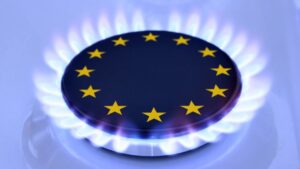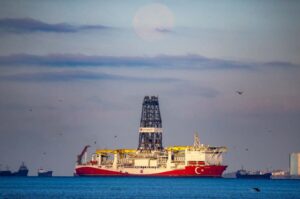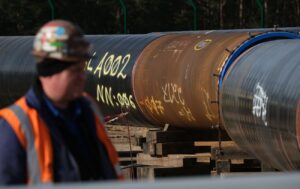
Natural gas supply to Ukraine from EU countries in November 2022 amounted to 228 mln. cubic meters, 27.7% less than in October (315.4 mln. cubic meters), operational data of GTS Operator of Ukraine show.
In particular, the supply of gas to the “customs warehouse” UGS in November made 191.1 million cubic meters against 261.9 million cubic meters in October.
In November, Romania with a modest volume of 0.3 million cubic meters was added to the gas supply to the Ukrainian GTS from Poland, Slovakia and Hungary. At the same time, in the morning of December 2, 8.7 million cubic meters of the total volume was received at the entrance from Romania out of a total of 18.1 million cubic meters. Romanian volumes bypassed the “customs warehouse”.
According to the analytical publication ICIS, Moldova imports gas from Romania through the Trans-Balkan pipeline. Volumes delivered through the Greece-Bulgaria interconnector (IGB) were physically sent north to Moldova via the Trans-Balkan line via Romania and Ukraine.
Once the volumes enter Moldova through the southern border crossing of Causeni, they can be subtracted from the volumes entering Moldova from Ukraine through the Grebeninki border crossing in the north, a regional source told ICIS.
“It took almost six years to unblock the network in the region and start physical gas supplies from alternative directions,” former UGTSU head Sergei Makogon said in a comment to ICIS.
As reported, in September 2022, from the territory of Poland, Slovakia and Hungary to Ukraine received 29.4 million cubic meters (TC – 17.4 million cubic meters), August – 142.1 million cubic meters (120.7 million cubic meters), July – 119 million cubic meters (82.6 million cubic meters). The Trans-Balkan Gas Pipeline is located in the northern part of the Russian Federation, in July – 119 million cubic meters (82.6 million cubic meters), June – 46.1 million cubic meters (6.6 million cubic meters), May – 24 million cubic meters (4.9 million cubic meters), April – 3.2 million cubic meters (3.2 million cubic meters), March – 282.3 million cubic meters (10 million cubic meters), February – 349.7 million cubic meters (11 million cubic meters), January – 47 million cubic meters (0.0 million cubic meters).
The Trans-Balkan pipeline is a trunk gas pipeline crossing the territory of Ukraine, Moldova, Romania, Bulgaria and Turkey.

Ankara intends to produce oil and gas in the waters of Libya within the framework of the energy agreement concluded by Turkey with this country, Turkish President Recep Tayyip Erdogan said.
“After the agreement on hydrocarbons signed by us with Libya, we will cooperate in a new area – in the extraction of oil and other resources from the Libyan continental shelf,” Bloomberg quotes him as saying.
Erdogan also announced plans to double the capacity of the Trans-Anatolian gas pipeline (TANAP), which runs from Azerbaijan through Georgia and Turkey to Greece.
Bloomberg recalls that Ankara and the administration of Abdel Hamid al-Dbeiba concluded this agreement last week: he was supposed to leave the post of prime minister after December 25, 2021, but did not do this, citing the disruption of the presidential elections in Libya. As a result, the Prime Minister of another Libyan government, Fathi Bashaga, rejected this agreement, emphasizing that al-Dbeiba does not have the authority to conclude agreements with foreign states.
At the same time, the current agreements are based on the 2019 agreement that Ankara concluded with the previous internationally recognized government of Libya, and to which Turkey provided military assistance in the confrontation with the forces of Marshal Khalifa Haftar.
In turn, the EU said that the new agreement does not comply with the UN Convention on the Law of the Sea and violates the interests of third parties. Also, Greece, Cyprus and Egypt regard the agreement as an attempt by Turkey to dominate the waters of the region.
In Libya, for a long time, there were two bodies of executive power in parallel: the Government of National Accord in Tripoli, in the west of the country, and an interim cabinet in the east of the country, supported by the army of Marshal Khalifa Haftar. According to Western media, Haftar’s forces were supported by Russia, France, Saudi Arabia, the United Arab Emirates, Egypt, Greece and Cyprus. On the side of the government in Tripoli, in turn, were Turkey, Qatar and Italy.
In October 2021, in Geneva, representatives of the warring parties signed an agreement on a permanent ceasefire. The presidential elections in Libya, the first after the overthrow and assassination of Muammar Gaddafi, were scheduled for December 24, 2021, but in the end the vote did not take place. This was due to controversy surrounding the electoral law.
GAS, OIL, PRODUCTION, TURKEY

Azerbaijani gas supplies to Europe will increase by 40% to 11.5 billion cubic meters in 2022, Azerbaijani President Ilham Aliyev said.
“In 2022, our export will reach 22 billion cubic meters, of which 11.5 billion cubic meters will be supplied to consumers in Europe. In 2021, 8.2 billion cubic meters was supplied to Europe. This means a 40% increase in the supplies in 2022,” Aliyev said at the ceremony for putting into commercial operation the Gas Interconnector Greece-Bulgaria (IGB) in Sofia on Saturday.
In accordance with the agreements with the European Union, Azerbaijan plans to at least double its gas export to Europe by 2027.
For that purpose, Baku has begun consultations with its partners on the issue of expansion of the Trans-Anatolian Natural Gas Pipeline (TANAP) to 32 billion cubic meters of gas a year and the Trans Adriatic Pipeline (TAP) to 20 billion cubic meters of gas a year, Aliyev said.
“We have already begun consultations with our partners on the expansion of the TANAP from 16 billion cubic meters to 32 billion cubic meters and the TAP from 10 billion cubic meters to 20 billion cubic meters. Because without it it will be difficult to ensure additional supplies,” the president said.
Aliyev said Azerbaijan has the capabilities to increase the gas export volumes by starting extraction at some other gas deposits.

As of the end of August 2022, Ukraine has accumulated 13 billion cubic meters of gas in its underground storage facilities (UGS). m of natural gas, said the head of the GTS Operator of Ukraine Serhiy Makogon in an interview with Interfax-Ukraine.
“Now there are 13 billion cubic meters of gas in underground storage facilities. By October 15, according to forecast calculations, there will be about 14.4 billion cubic meters of gas. With such reserves, it is realistic to get through a mild winter, since today gas consumption has significantly decreased,” he said.
At the same time, the head of the operator noted, the military threat factor increases the risks of a stable heating season, so additional imports would be appropriate.
“As a GTS operator, we can assure that the transport routes for receiving gas from Poland, Slovakia and Hungary are ready to import in the amount of 54 million cubic meters per day. We hope that colleagues from Naftogaz will be able to take advantage of these opportunities to purchase gas,” Makogon said. .
As reported, as of the end of July, gas reserves in Ukraine’s UGS facilities reached 12 billion cubic meters. m.

Moldovan state company Energocom will buy 10 million cubic meters of natural gas for $16.6 million from Moldovagaz, which gets gas from Russia’s Gazprom, Deputy Prime Minister and Infrastructure and Regional Development Minister Andrei Spinu said on his Telegram channel, citing a decision made by the country’s National Commission for Emergency Situations.
“This transaction will also enable Moldovagaz to pay the advance for August by September 1,” Spinu said.
It was reported earlier that the the National Commission for Emergency Situations, which is chaired by Prime Minister Natalia Gavrilita, had ordered state company Energocom to buy 10 mcm of natural gas for storage in Romania.
The gas will be purchased and delivered under a framework EFET (European Federation of Energy Traders) type purchase-sale contract between Energocom and Moldovagaz, the government’s press service told Interfax.
For the first tranche of 5 mcm, the purchase price will be about $1,459 per 1,000 cubic meters. The second tranche of the gas purchase will be made in September at a price of $1,881 per 1,000 cubic meters.
The gas will be stored in neighboring Romania, as Moldova does not have its own gas storage facilities.
Moldovagaz was unable to pay an advance to Gazprom for supplies in August and the Russian company agreed to defer the payment to September 1. Moldovagaz said that current gas rates in the country do not cover its purchase price.
The commission also decided to allocate MDL 322 million from the state budget to increase Energocom’s charter capital.

The spot price of gas in Europe soared above $2,700/ths. cube m for the news about the new repair on the Nord Stream highway.
The price of the nearest (September) TTF futures on the ICE Futures exchange on Friday evening reached $2,712 per thousand cubic meters.
On Friday evening, Gazprom announced that the only working gas-compressor unit of the Nord Stream main’s departure compressor station at the Portovaya CS would be shut down from August 31 to September 2 for three days for maintenance and scheduled preventive work.
The gas pipeline is capable of transporting up to 167 million cubic meters per day. m of gas, but the capacity was reduced due to the violation of the maintenance schedule for the equipment of the starting station of the sea main – the compressor station “Portovaya”. It is equipped with gas compressor units from Rolls-Royce, whose gas turbine business has been taken over by Siemens. Due to Canadian sanctions imposed in response to the military aggression of the Russian Federation in Ukraine, one turbine did not return to Russia from the Siemens Energy repair base on time. In the meantime, the time has come for a major overhaul of other engines, both in connection with the operating time between overhauls and in connection with breakdowns.